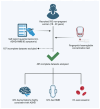Women with Symptoms Suggestive of ADHD Are More Likely to Report Symptoms of Iron Deficiency and Heavy Menstrual Bleeding
- PMID: 40077654
- PMCID: PMC11902013
- DOI: 10.3390/nu17050785
Women with Symptoms Suggestive of ADHD Are More Likely to Report Symptoms of Iron Deficiency and Heavy Menstrual Bleeding
Abstract
Background/objectives: Iron deficiency has been suggested as a potential mechanism for attention-deficit hyperactivity disorder (ADHD) development due to involvement in neurotransmitter synthesis and transporter expression. As iron deficiency is particularly common in women of reproductive age, often due to heavy menstrual bleeding (HMB), we aimed to explore the relationship between iron deficiency, HMB and ADHD in women.
Methods: We screened women (18-49 years) at university and local sporting events in Western Australia. To screen for ADHD, section A of the Adult ADHD Self-Report Scale-V1.1 (ASRS-V1.1) and the Adult Concentration Inventory were used to assess cognitive disengagement syndrome (CDS) symptoms. Risk factors for iron deficiency, such as HMB, commonly reported symptoms and a fingerpick haemoglobin concentration (Hb) (Hemocue Hb801) were recorded.
Results: Of the 405 completed questionnaires, the mean age was 24.8 ± 10.1 years, the mean Hb was 136.8 ± 12.4 g/L and 6.4% of women were anaemic. Symptoms suggestive of ADHD were reported by 174/405 (43%) women, and 128/405 (32%) women reported HMB. There was a greater prevalence of HMB reported in those experiencing symptoms suggestive of ADHD (39% vs. 26%, p = 0.01). Symptoms of fatigue, dizziness, brain fog, anxiety, heart palpitations, headaches, restless legs and depression were more common in patients with symptoms suggestive of ADHD (p ? 0.01) and HMB (p < 0.05). Anaemia status did not influence ADHD status (p = 0.87) nor CDS scores (15.7 ± 7.0 vs. 13.8 ± 6.1, p = 0.17).
Conclusions: There is an apparent relationship between those with symptoms reported in ADHD, HMB and iron deficiency. Further exploration is required to determine whether there is a causative relationship.
Keywords: attention; iron deficiency; reproductive age women.
Conflict of interest statement
The authors declare no conflicts of interest.
Figures
Similar articles
-
The relationship between menorrhagia, iron deficiency, and anaemia in recreationally active females: An exploratory population based screening study.J Sci Med Sport. 2024 Jul;27(7):437-450. doi: 10.1016/j.jsams.2024.04.012. Epub 2024 May 2. J Sci Med Sport. 2024. PMID: 38749874
-
Greater prevalence of anaemia and heavy menstrual bleeding reported in women of reproductive age in the United Kingdom compared to Australia.Br J Haematol. 2025 May;206(5):1479-1484. doi: 10.1111/bjh.20075. Epub 2025 Apr 9. Br J Haematol. 2025. PMID: 40200857 Free PMC article.
-
Community screening for iron deficiency in reproductive aged women: Lessons learnt from Australia.Vox Sang. 2025 Jan;120(1):22-31. doi: 10.1111/vox.13750. Epub 2024 Oct 13. Vox Sang. 2025. PMID: 39396927 Free PMC article.
-
A Review of Clinical Guidelines on the Management of Iron Deficiency and Iron-Deficiency Anemia in Women with Heavy Menstrual Bleeding.Adv Ther. 2021 Jan;38(1):201-225. doi: 10.1007/s12325-020-01564-y. Epub 2020 Nov 27. Adv Ther. 2021. PMID: 33247314 Free PMC article. Review.
-
High Prevalence of Congenital Factor VII (FVII) Deficiency in Adolescent Females with Heavy Menstrual Bleeding and Iron Deficiency Anemia.J Pediatr Adolesc Gynecol. 2022 Dec;35(6):647-652. doi: 10.1016/j.jpag.2022.07.013. Epub 2022 Jul 30. J Pediatr Adolesc Gynecol. 2022. PMID: 35917902 Review.
References
-
- Li T., Mota N.R., Galesloot T.E., Bralten J., Buitelaar J.K., IntHout J., AriasVasquez A., Franke B. ADHD symptoms in the adult general population are associated with factors linked to ADHD in adult patients. Eur. Neuropsychopharmacol. 2019;29:1117–1126. doi: 10.1016/j.euroneuro.2019.07.136. - DOI - PubMed
-
- Ebejer J.L., Medland S.E., van der Werf J., Gondro C., Henders A.K., Lynskey M., Martin N.G., Duffy D.L. Attention deficit hyperactivity disorder in Australian adults: Prevalence, persistence, conduct problems and disadvantage. PLoS ONE. 2012;7:e47404. doi: 10.1371/journal.pone.0047404. - DOI - PMC - PubMed
-
- American Pyschiatric Association . Diagnostic and Statistical Manual of Mental Disorders (DSM-5-TR®) 5th ed. American Pyschiatric Association; Washington, DC, USA: 2022.
MeSH terms
Substances
LinkOut - more resources
Full Text Sources
Medical
Research Materials



